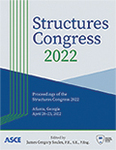Deep Neural Network (DNN) Model to Predict Close-In Blast Load
Publication: Structures Congress 2022
ABSTRACT
In recent years, the use of machine learning (ML) has been expanded to several engineering fields with applications in structural engineering. Deep neural network (DNN) models have been implemented to predict structural response of systems under conventional loading. Some of those DNN models are based on data sets of images, test data, and/or finite element models built for a specific environment; the accuracy of these models relies on the size of the data set that can vary from hundreds to thousands of data points. Since DNN models rely on data, their use in blast analysis and/or design is limited to the availability of data, which most of the time is scarce or restricted. This paper introduces the implementation of an ML/DNN model for the prediction of close-in blast loads based on experimental data from multiple blast test programs managed and executed by Stone Security Engineering, P.C. The blast tests were conducted at the Stone-OBL Open-Air Blast Test Facility (outside of Bend, Oregon) with multiple threat sizes and standoffs from the Stone-OBL rigid reaction structure. The current intent of this ML/DNN model is to provide a prediction tool to blast engineers to easily estimate loads from close-in range scenarios in upcoming blast test programs, thus reducing cost and time and optimizing the level of calibration tests that might be needed. This paper shows the accuracy of the model based on test data and compared with computational fluid dynamics (CFD) runs. Example cases are presented to illustrate ML/DNN model output.
Get full access to this article
View all available purchase options and get full access to this chapter.
REFERENCES
ConWep. (2019). Conventional Weapons Effects. US Army Engineer Research & Development Center, Vicksburg, MS.
DoD. (2014). Structures to Resist the Effects of Accidental Explosions, with change 2. UFC 3-340-02. DoD, Washington, DC.
Goodfellow, I., Bengio, Y., and Courville, A. (2016). Deep Learning. MIT Press.
Jupyter Notebook. (2021). Opensource web application. Version 6.3.0. <https://jupyter.org>.
Nielsen, M. (2015). Neural Networks and Deep Learning. Determination Press. <http://neuralnetworksanddeeplearning.com>.
ProSAir. (2018). Computational Blast Loading Tool. Version 2018.4. Cranfield University, Cranfield, UK. <https://www.cranfield.ac.uk/facilities/prosair-computational-blast-loading-tool>.
Stewart, M., Netherton, M., and Baldacchino, H. (2020). “Observed airblast variability and model error from repeatable explosive field trials” International Journal of Protective Structures, 11(2), 235–257.
TensorFlow. (2021). Opensource software for ML modeling. Version 2.4.1. <https://www.tensorflow.org>.
Information & Authors
Information
Published In
History
Published online: Apr 18, 2022
Authors
Metrics & Citations
Metrics
Citations
Download citation
If you have the appropriate software installed, you can download article citation data to the citation manager of your choice. Simply select your manager software from the list below and click Download.
